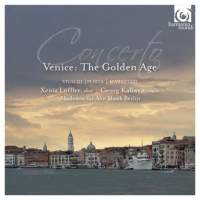Texte paru dans: / Appeared in:
*

International Record Review - (11//2014)
Pour
s'abonner / Subscription information
Harmonia Mundi
HMC902185

Code-barres / Barcode : 3149020218525
Consultez toutes les évaluations recensées pour ce cd
~~~~ Reach all the evaluations located for this CD
Akademie für Alte Musik Berlin celebrates Venice's Golden Age of music with some thoughtfully chosen pieces, The main beneficiary is Vivaldi, and that is how it should be, but there is also Alessandro Marcello's well‑known Oboe Concerto in D minor which Bach transcribed for solo harpsichord (BWV974), a Sinfonia by Giovanni Porta, who was Maestro di Coro at the Ospedale della Pietà during the 1720s and early to mid‑1730s, an overture by Vivaldi's younger violin virtuoso coiltemporary Carlo Tessarini and a concerto for oboe and strings by Uri Rom. Rom has subtitled his piece 'L'Olimpiade'. He wrote it in 2013, describing it as a 'quasi‑pasticcio after Antonio Vivaldi and Carlo Tessarini'. The piece is dedicated to the oboist Xenia Löffler, who plays a prominent role on the disc as soloist in five of the eight works.
The rarities here are the
Porta Sinfonia in D major for strings, the Tessarim Overture in D major and
Vivaldi's four‑movement Concerto for violin, oboe and strings, RV Anh. 18.
This last‑mentioned piece is not to be confused with his fairly well‑known
Concerto in B flat for violin, oboe and strings, RV548. Rather, it is an
arrangement by an unidentified hand, perhaps that of a Dresden oboist, based
in part on a movement from a Violin Concerto in the same key, RV364a. The
Sinforia by Porta almost certainly was played by the Dresden court
orchestra, since not only is it held in the Dresden Hofkapelle archive but
also may contain ornamentation by the orchestra's celebrated leader, Johann
Georg Pisendel. Vivaldi's colourfully scored Concerto in G minor, RV576, was
specifically composed for the Dresden players and affords an attractive
example of the composer's skill in deploying instruments of disparate
colours.
As I have implied, the star turn here is Löffler, whose evenly spoken
playing, communicative articulation and dextrous technique make her one of
the most accomplished Baroque oboe players around at present. Vivaldi's Oboe
Concerto in C major which he adapted from one for bassoon in the same
key (RV471) sparkles with vitality and ornamentally well‑judged virtuosity,
while elsewhere her solo partnership with Georg Kallweit, who also leads the
unanimously responsive Akademie für Alte Musik Berlin, demonstrates a
pleasing rapport. Vivaldi's Concerto in E minor for strings, with a taut
fugal opening, and Rom's enjoyable pasticcio set the seal,on an
alluring evocation of La Serenissima.
Fermer la fenêtre/Close window
Cliquez l'un ou l'autre
bouton pour découvrir bien d'autres critiques de CD
Click either button for many other reviews


